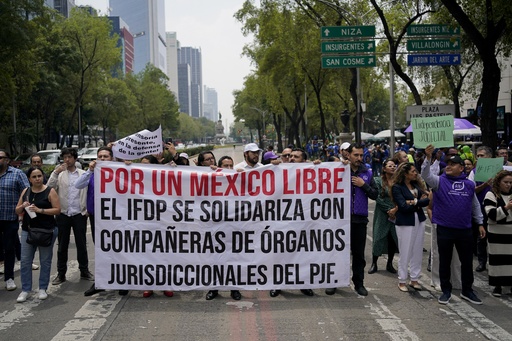Mexico’s ruling party is advocating for a radical proposal to address corruption within the country’s current judicial system. The proposal suggests that Mexico’s entire judicial branch, consisting of roughly 7,000 judges, should stand for election. President Andrés Manuel López Obrador is leading this initiative as he nears the end of his six-year term.
Contrary to practices in countries like Switzerland and the United States where judges are elected indirectly or at the local level, the proposal in Mexico aims for citizens to vote on every judge, appeals court member, and up to the Supreme Court justice. Throughout his term, President López Obrador has often clashed with judges, fueling the urgency for judicial reform.
While the proposed overhaul has garnered criticism both domestically and internationally, numerous uncertainties and crucial questions remain unanswered. The election process for judges would stipulate that candidates need a law degree, decent academic performance, five years of unspecified “judicial area experience,” and a recommendation letter to run for certain judgeships. The selection process would involve a committee of experts narrowing down candidates, with finalists chosen randomly in some cases. Supreme Court justices, requiring a decade of experience, would also be elected.
Key details such as the number of candidates on the ballots and funding for election campaigns remain ambiguous. Concerns arise regarding voter research on candidates and potential influences from political parties. Moreover, financial backers for candidates could pose conflicts of interest in court cases.
The current pathway to becoming a judge involves gradual progress through periodic evaluations and committees. The existing system is criticized for instances of nepotism and bias, leading to lax repercussions for corrupt judges. Additionally, nominations for high-level positions sometimes involve legislative or executive branch selection.
The proposed reform also includes the introduction of “faceless” judges for organized crime cases to shield their identities and prevent threats. A judicial disciplinary committee would be established to address misconduct and investigate judges beyond traditional constraints. Further changes involve reducing the Supreme Court’s justices from 11 to nine and shortening their terms from 15 to 12 years.
For the overhaul to materialize, it must secure approval from both chambers of Congress. The lower chamber, dominated by the ruling party, has already voted in favor, with the Senate expected to pass the measure by a slight margin. Subsequently, the reform would need affirmation from 17 state legislatures, where the ruling party holds significant support.
Upon implementation, the process of organizing extensive elections, dismissing current judges, and providing severance pay would ensue. As newly elected judges step into unfamiliar specialized courtrooms and appeals courts, a substantial learning curve is anticipated.
Advocates of the reform believe that empowering voters in judge selection would enhance accountability and facilitate the discipline of errant judges. However, Mexico’s core issue lies in the inadequate training and overwhelming workload of police and prosecutors, resulting in the majority of crimes going unprosecuted.
While Bolivia initiated judge voting in 2009, the process faced challenges as voters submitted blank ballots, leading to its suspension. This echoes the complexities and uncertainties surrounding Mexico’s ambitious judicial reform proposal.



